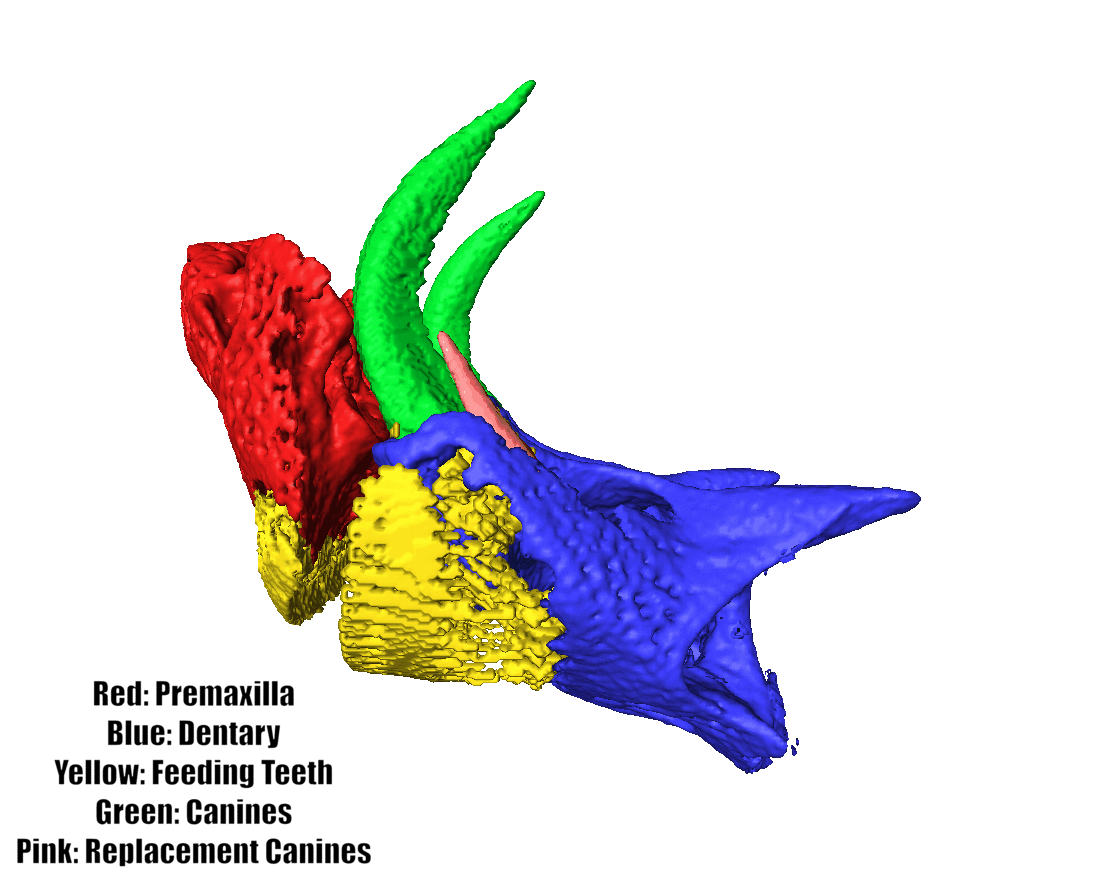Scarus frenatus, the bridled parrotfish
Muraena lentiginosa, the jewel moray
Acanthurus mata, the elongate surgeonfish
Current Research
Understanding the relationship between tooth complexity and tooth function in fishes
Previous studies in mammals and reptiles have demonstrated that herbivores generally have more complex dentitions than omnivores and carnivores. This pattern is attributed to the tough, fibrous properties of things like leaves, roots, and shoots, which require greater manipulation and processing prior to digestion. Fishes demonstrate an incredible range of dental diversity, but their dentitions are vastly under-studied due in part to the challenges of continual tooth replacement, high variation in tooth form and number along the jaws, and a two-jaw system that allows for prey capture and processing to be decoupled.
To address this tooth knowledge gap, we use a combination of novel tooth functional categories, microCT scanning, and a metric called orientation patch count rotated (OPCR) within a phylogenetic comparative framework to determine whether tooth function is associated with tooth complexity across a broad sample of reef-associated fishes.
While we generally expect tooth complexity to correlate with function based on previous studies in mammals and reptiles, fishes exhibit far greater dental diversity than other vertebrates (example: see the parrotfish beak at the top of this page!). While trophic novelties such as 'beaked' dentition may lead to higher tooth complexity, these patterns may be driven more so by the novelty of fused dentition, and less so by the specific material properties of plant material.
Click here to see my talk at the 3rd Joint Congress on Evolutionary Biology further explaining these results!


Investigating best-practices for applying quantitative tooth complexity metrics to fishes
Teeth are essential to understanding the evolutionary history and ecological diversification of vertebrates. However, our knowledge of dentitions is historically based upon qualitative descriptions and largely restricted to mammals. Rapid advancement of 3D-imaging techniques such as Orientation Patch Count Rotated (OPCR) can accurately measure tooth surface complexity to test for ecological correlates, such as diet. While OPCR has been successfully applied across numerous studies of mammal and reptile dentitions, it has yet to be applied to fishes.
Fish dentitions remain remarkably under-studied due in part to the challenges of continual tooth replacement, high variation in tooth form and number along the jaws, and a two-jaw system that allows for prey capture and processing to be decoupled. In this study, we provide a guide of OPCR best-practices for fish teeth, using a microCT dataset of damselfish (Pomacentridae) dentitions. We also investigate the influence of several important methodological choices taken at different stages of the OPCR analysis workflow on the outcome of analyses.
The goal of this guide is to provide comparative biologists with a useful framework that leverages open access software to conduct their own integrative studies on dental complexity in fishes and other non-mammalian vertebrates. Stay tuned for more exciting developments with this project!

Re-thinking modes of teleost tooth replacement using the dentally diverse combtooth blennies (Blenniidae)
Modes of tooth replacement in teleost fishes have historically been defined in one of two ways: extraosseous, in which teeth are replaced in soft tissue sitting outside of the bone of attachment, or intraosseous in which teeth develop inside bony crypts from within the attachment bone. However, increasing amounts of evidence suggest that these modes represent opposite ends of a tooth replacement continuum, rather than discretely binned categories. Combtooth blennies are an excellent example of a family of fishes that exhibit both modes of tooth replacement, as well as possessing modes that defy standard classification. In this study we aim to re-examine how modes of tooth replacement are defined across teleosts using combtooth blenny dentition as our model.
This project represents the second chapter of my MS thesis. Click the box below to view a poster from SICB 2021 summarizing this ongoing study.
Tooth replacement in the bluestriped fangblenny, Plagiotremus rhinorhynchos

premaxilla_tif.png)

Research Collaborations
Does mouth-brooding influence head and body shape evolution in cichlids?
In this project, we are investigating whether the fascinating parental care behavior of mouth-brooding has an effect on head and body shape in cichlids. We compare mouth-brooding and substrate brooding species across both African and South American lineages to determine whether mouth-brooding influences morphology and rates of morphological evolution.
Project conception and data collection for this study was led by a team of stellar undergraduates as part of Clemson's Creative Inquiry initiative. They presented their work at SICB in 2021 and did an excellent job sharing their findings!

Satanoperca leucosticta, mouthbrooder


Cichlasoma portalegrense, substrate brooder
Unraveling the effects of adaptation and history in the phenotypic convergence of fishes
This is a collaborative lab project led by Dr. Jennifer Hodge. In this study, we are exploring how convergent evolution plays out in planktivorous fishes. Plankton is one of the most common prey items among fishes, with many species evolving to selectively feed only on these micro-organisms. What we don't know is the extent to which planktivory selects for the same body traits, or the extent to which ancestral history influences selection. In other words, is there more than one way for fishes to evolve morphologically to eat plankton, or are some fishes constrained by their evolutionary history and unable to reach an optimal planktivorous phenotype? Stay tuned for more developments with this project!
Previous Research
Tooth replacement in the Pacific Leaping Blenny
Modes of teleostean fish tooth replacement and attachment have historically been described using discrete classification systems that categorize major patterns across taxa. While useful, these classification schemes overlook more complex dentitions, such as the "unattached" feeding teeth found in salariin combtooth blennies (yellow structures in CT images below). In this study, we establish a descriptive model of tooth replacement and attachment for the Pacific Leaping Blenny, Alticus arnoldorum. We then use our model to propose hypotheses of tooth function in salariin blennies.
This study represents the first chapter of my MS thesis. Click the video below to watch the terrestrial A. arnoldorum feeding in action!

